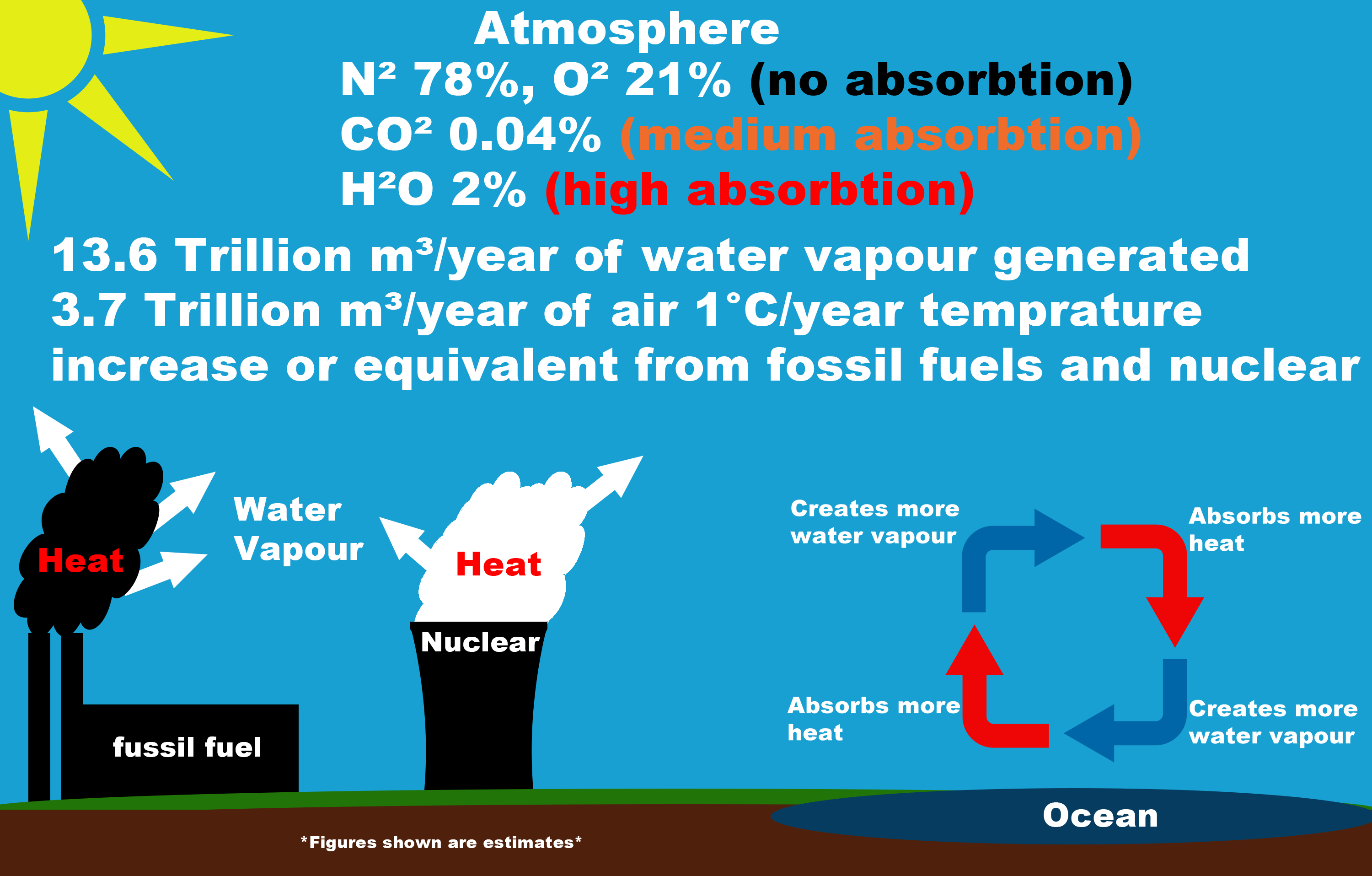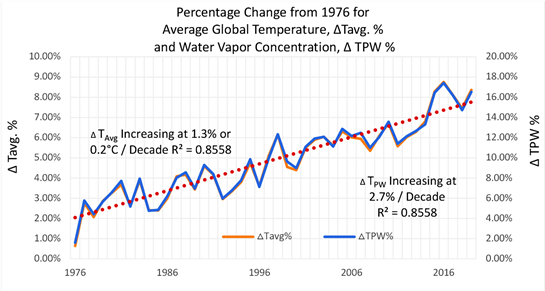Historically, Carbon and CO2 remain the principal terms of reference regarding climate change due to the association of hydrocarbon fuel utilisation and the resulting negative climatic warming effects. The result of this association may however be leading us on a false mission by disregarding a much greater ‘self- perpetuating’ influence which is that of ‘water vapour’.
Water vapour is a primary product of hydrocarbon combustion along with CO2 and heat, although water has a much greater specific heat capacity and absorption rate than CO² and also makes up a much higher and increasing percentage of the atmosphere.

Combustion processes generate heat which is transferred to the major atmospheric gas constituent Nitrogen – although itself is not part of the combustion process. It is the kinetic transfer of heat that predominantly warms our atmosphere as neither Nitrogen or Oxygen (the major constituents) are warmed directly by solar radiation. It has however been generally concluded that CO2 is the major causation of global warming and that H2O (water vapour) is an ‘amplifying effect’? The apparent reasoning for this is that CO2 remains in the atmosphere for much longer than water vapour – which is a logic that I find difficult to comprehend. A balloon can stay in the air longer than an aeroplane – however, it does nor mean that it has used more fuel!
Water requires heat to form vapour and as the atmospheric temperature rises due to our human derived (anthropogenic) activities such as direct and indirect hydrocarbon combustion and other non-renewable technologies such as nuclear power and geothermal generation – this heat further circulates to increase the amount of water vapour which additionally absorbs radiation causing this water vapour heating cycle to become increasingly self-perpetuating and potentially exponential.

You can see from this diagram that global air temperature and water vapour concentration almost directly correlate.
It is estimated that the proportion of atmospheric water vapour will increase by about 7% per °C of warming! On the other hand – CO2 represents a much lower proportion of the atmosphere (whilst also increasing) although importantly is NOT able to self-perpetuate. The amounts of CO2 produced are almost completely controlled by humans and can therefore be reduced accordingly.
There however remains conjecture within climate science as many believe that water vapour has a ‘cooling effect’ which will increase with additional cloud formations reflecting more incoming solar radiation. The reality is that no one really knows – which has led to a huge variability in current climate forecasts!
One of the problems with the complexities of climate science is explaining how relatively small increases of things such as CO2 can have potentially large effects. This is also true with human induced (anthropogenic) heating and water vapour – however, seemingly determined differently by the very same science that propagates CO2 as the major warming factor!
A question therefore is – why is H2O (water vapour) and anthropogenic heat not considered to be ‘causations’ of global warming – as if we underestimate these, many of our solutions may not be effective? Increased precipitation that we are currently experiencing is natures way of trying to balance the increase in atmospheric water vapour although the response is always likely to ‘lag’ the cause and so one method and perhaps the only in which this may be addressed would be in ‘engineering’ cloud seeding to encourage additional precipitation?
Whilst it may be true that some of the same solutions may be required to limit/reduce both water vapour and CO2 – it would be remiss not to address water vapour as the primary and critical objective where differing solutions are available. Additionally, the general belief that nuclear power will provide a long-term solution to this problem is misplaced given the large amounts of water vapour and heat produced in the process potentially making the problem worse at high public expense. I therefore believe international policies should be fully focussed on a complete transition to renewables based on solar, wind and hydro technologies in a rapid manor – along with investigating cloud seeding technologies.
These general concerns may not necessarily be portrayed by the international media, many scientific or inter- governmental bodies and I would be pleased if proven incorrect – however, unfortunately doubt that they will?
The good news however is that smart adaption allowing the additional utilisation of water technologies can provide the solutions and businesses such as ours remain committed to developing and delivering these current and future solutions.
Phil Selwyn CEO/Founder Water Powered Technologies


